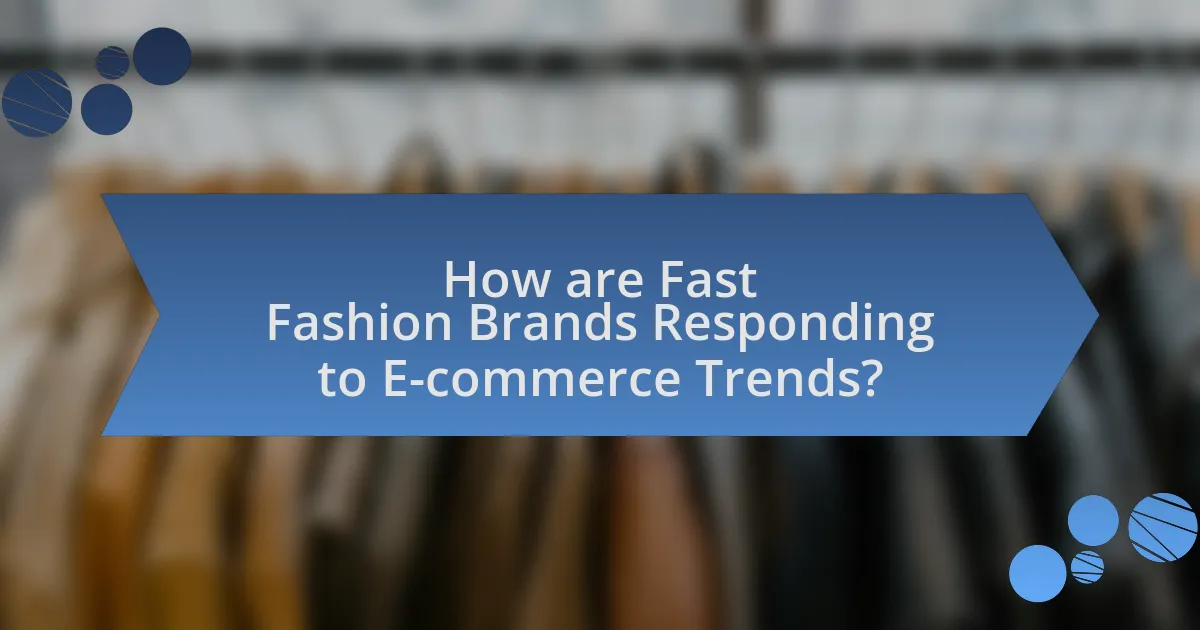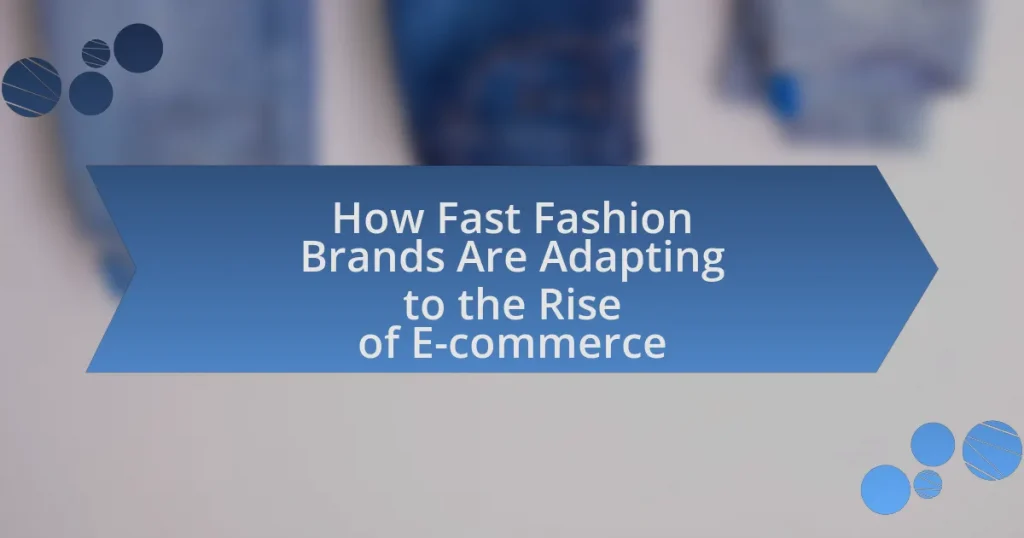Fast fashion brands are increasingly adapting to the rise of e-commerce by enhancing their online presence and optimizing supply chains for faster delivery. Key strategies include leveraging data analytics to tailor offerings, investing in advanced logistics, and utilizing social media marketing to engage younger consumers. The article explores the factors driving e-commerce growth in the fashion industry, the impact of changing consumer behavior, and the technological advancements shaping online shopping. Additionally, it addresses the challenges fast fashion brands face, such as sustainability concerns and logistical complexities, while providing insights into best practices for optimizing e-commerce strategies.

How are Fast Fashion Brands Responding to E-commerce Trends?
Fast fashion brands are responding to e-commerce trends by enhancing their online presence and optimizing supply chains for quicker delivery. Brands like Zara and H&M have invested in advanced logistics systems to reduce shipping times, allowing them to meet consumer demand for rapid fulfillment. Additionally, these brands are leveraging data analytics to understand consumer preferences and tailor their online offerings, which has been shown to increase sales by up to 30% in some cases. Furthermore, fast fashion companies are adopting social media marketing strategies to engage younger audiences, with platforms like Instagram and TikTok driving significant traffic to their online stores. This multi-faceted approach demonstrates how fast fashion brands are adapting to the evolving retail landscape shaped by e-commerce.
What factors are driving the rise of e-commerce in the fashion industry?
The rise of e-commerce in the fashion industry is primarily driven by technological advancements, changing consumer behavior, and the increasing demand for convenience. Technological advancements, such as mobile shopping apps and improved payment systems, have made online shopping more accessible and user-friendly. Changing consumer behavior, particularly among younger demographics who prefer online shopping over traditional retail, has significantly contributed to this trend. Additionally, the demand for convenience, including the ability to shop anytime and anywhere, has led to a surge in online fashion sales. According to a report by Statista, global e-commerce sales in the fashion sector are projected to reach $1 trillion by 2025, highlighting the substantial growth and importance of e-commerce in the fashion industry.
How has consumer behavior changed with the growth of online shopping?
Consumer behavior has shifted significantly with the growth of online shopping, leading to increased convenience and a preference for digital interactions. Consumers now prioritize speed and accessibility, often opting for online platforms over traditional retail due to the ability to shop anytime and anywhere. According to a 2021 report by Statista, 79% of consumers in the U.S. have shopped online, reflecting a strong trend towards e-commerce. Additionally, the rise of social media and mobile shopping has influenced purchasing decisions, with 54% of consumers stating they prefer to shop through mobile apps. This shift has compelled fast fashion brands to enhance their online presence and streamline their digital shopping experiences to meet evolving consumer expectations.
What technological advancements are influencing e-commerce in fashion?
Technological advancements influencing e-commerce in fashion include artificial intelligence, augmented reality, and blockchain technology. Artificial intelligence enhances personalized shopping experiences through data analysis, enabling brands to recommend products based on consumer behavior. Augmented reality allows customers to virtually try on clothing, improving engagement and reducing return rates; for instance, brands like Zara and ASOS have implemented AR features in their apps. Blockchain technology provides transparency in supply chains, ensuring authenticity and ethical sourcing, which is increasingly important to consumers. These advancements collectively drive efficiency and customer satisfaction in the fast fashion e-commerce landscape.
How are fast fashion brands adapting their business models for e-commerce?
Fast fashion brands are adapting their business models for e-commerce by enhancing their online presence, utilizing data analytics for inventory management, and implementing faster supply chain processes. These brands are investing in user-friendly websites and mobile applications to improve customer experience and increase sales. For instance, Zara has integrated real-time inventory tracking to ensure that popular items are readily available online, which has led to a reported 20% increase in online sales. Additionally, brands like H&M are leveraging social media marketing and influencer partnerships to reach a broader audience, further driving e-commerce growth.
What strategies are brands implementing to enhance online presence?
Brands are implementing strategies such as leveraging social media marketing, optimizing their websites for search engines, and utilizing influencer partnerships to enhance their online presence. Social media platforms like Instagram and TikTok allow brands to engage directly with consumers, showcasing products through visually appealing content. Search engine optimization (SEO) improves website visibility, driving organic traffic and increasing brand awareness. Influencer partnerships enable brands to tap into established audiences, enhancing credibility and reach. According to a 2022 report by Statista, 54% of consumers use social media to research products, highlighting the effectiveness of these strategies in reaching target demographics.
How are supply chain adjustments impacting fast fashion’s e-commerce success?
Supply chain adjustments are significantly enhancing fast fashion’s e-commerce success by enabling quicker response times to market trends and consumer demands. These adjustments, such as adopting just-in-time manufacturing and local sourcing, allow brands to reduce lead times and increase inventory turnover. For instance, companies like Zara have implemented agile supply chain practices that enable them to design, produce, and distribute new styles within weeks, compared to the traditional months-long cycle. This responsiveness not only meets the fast-paced nature of online shopping but also minimizes excess inventory, thereby reducing markdowns and increasing profitability.
What role does social media play in the e-commerce strategies of fast fashion brands?
Social media is integral to the e-commerce strategies of fast fashion brands, serving as a primary channel for marketing, customer engagement, and sales conversion. Fast fashion brands leverage platforms like Instagram and TikTok to showcase their latest collections, utilizing visually appealing content to attract consumers and drive traffic to their online stores. According to a 2021 report by McKinsey, 70% of consumers are influenced by social media when making purchasing decisions, highlighting its effectiveness in shaping consumer behavior. Additionally, social media facilitates direct interaction with customers, allowing brands to gather feedback and adapt their offerings in real-time, which is crucial in the fast-paced fashion industry.
How are brands leveraging influencer marketing to boost online sales?
Brands are leveraging influencer marketing to boost online sales by collaborating with social media influencers who have established trust and a large following among their target demographics. This strategy allows brands to reach a wider audience and enhance brand visibility, as influencers create authentic content that showcases products in a relatable context. For instance, a study by the Digital Marketing Institute found that 49% of consumers depend on influencer recommendations, highlighting the effectiveness of this approach in driving purchasing decisions. Additionally, brands often utilize affiliate marketing links provided to influencers, enabling them to earn commissions on sales generated through their promotions, which further incentivizes influencers to actively promote the products.
What platforms are most effective for fast fashion e-commerce marketing?
Social media platforms, particularly Instagram and TikTok, are the most effective for fast fashion e-commerce marketing. These platforms enable brands to showcase visually appealing content, engage with a younger audience, and leverage influencer partnerships. For instance, a study by Statista indicates that 54% of consumers use social media to research products, highlighting its importance in the purchasing decision process. Additionally, TikTok’s algorithm promotes viral content, allowing fast fashion brands to reach a wider audience quickly, as evidenced by brands like Shein, which gained significant traction through viral challenges and user-generated content.

What challenges do fast fashion brands face in the e-commerce landscape?
Fast fashion brands face significant challenges in the e-commerce landscape, primarily due to intense competition and sustainability concerns. The rapid growth of online shopping has led to an oversaturated market, where numerous brands vie for consumer attention, making it difficult for fast fashion companies to differentiate themselves. Additionally, increasing consumer awareness regarding environmental impact and ethical production practices pressures these brands to adopt more sustainable practices, which can conflict with their traditional business models focused on low-cost, high-volume production. According to a 2021 report by McKinsey & Company, 67% of consumers consider sustainability when making a purchase, highlighting the urgency for fast fashion brands to adapt to these changing consumer expectations.
How do issues of sustainability affect fast fashion’s e-commerce strategies?
Issues of sustainability significantly impact fast fashion’s e-commerce strategies by compelling brands to adopt more environmentally friendly practices and transparent supply chains. As consumers increasingly prioritize sustainability, fast fashion retailers are integrating eco-friendly materials and ethical production methods into their online offerings. For instance, brands like H&M and Zara have launched sustainable collections and improved their logistics to reduce carbon footprints, responding to consumer demand for responsible shopping options. This shift not only enhances brand reputation but also aligns with market trends, as a 2021 survey indicated that 66% of global consumers are willing to pay more for sustainable brands. Thus, sustainability issues drive fast fashion e-commerce strategies towards greater accountability and innovation in product offerings.
What measures are brands taking to address environmental concerns?
Brands are implementing various measures to address environmental concerns, including adopting sustainable materials, enhancing supply chain transparency, and committing to circular economy practices. For instance, many fast fashion brands are increasingly using organic cotton, recycled polyester, and other eco-friendly materials to reduce their environmental footprint. Additionally, brands are improving supply chain transparency by disclosing sourcing practices and labor conditions, which helps consumers make informed choices. Furthermore, initiatives such as take-back programs and recycling schemes are being introduced to promote circularity, allowing consumers to return used garments for recycling or repurposing. These actions are supported by industry reports indicating that sustainable practices can significantly reduce waste and resource consumption in the fashion sector.
How does consumer demand for ethical practices influence e-commerce approaches?
Consumer demand for ethical practices significantly influences e-commerce approaches by compelling brands to adopt sustainable and transparent business models. As consumers increasingly prioritize ethical considerations, such as fair labor practices and environmentally friendly materials, e-commerce platforms are integrating these values into their operations. For instance, a 2021 survey by McKinsey found that 67% of consumers consider sustainability when making a purchase, prompting e-commerce brands to showcase their ethical sourcing and production processes prominently. This shift not only enhances brand loyalty but also drives competitive differentiation in a crowded market, as companies that align with consumer values can attract a more conscientious customer base.
What logistical challenges arise from fast fashion’s shift to e-commerce?
Fast fashion’s shift to e-commerce presents several logistical challenges, primarily including inventory management, supply chain complexity, and fulfillment speed. Inventory management becomes difficult as brands must balance stock levels to meet fluctuating online demand while minimizing excess inventory, which can lead to increased costs. Supply chain complexity arises from the need to coordinate multiple suppliers and distribution centers, often across different regions, complicating logistics and increasing the risk of delays. Fulfillment speed is critical in e-commerce, as consumers expect rapid delivery; fast fashion brands must optimize their logistics to ensure timely shipping, which can strain existing infrastructure and require significant investment in technology and processes. These challenges are compounded by the need for returns management, as e-commerce typically sees higher return rates, necessitating efficient reverse logistics systems.
How are brands managing inventory and fulfillment in an online environment?
Brands are managing inventory and fulfillment in an online environment by implementing advanced technologies and data analytics to optimize stock levels and streamline logistics. For instance, many brands utilize real-time inventory management systems that track stock across multiple channels, allowing for accurate forecasting and reducing overstock or stockouts. According to a report by McKinsey, companies that leverage data analytics in their supply chain can improve their inventory turnover rates by up to 30%. Additionally, brands are increasingly adopting drop-shipping models and partnering with third-party logistics providers to enhance fulfillment speed and efficiency, which is crucial in the fast-paced e-commerce landscape. This approach not only minimizes warehousing costs but also enables brands to respond quickly to changing consumer demands.
What technologies are being adopted to streamline e-commerce logistics?
Technologies being adopted to streamline e-commerce logistics include artificial intelligence (AI), machine learning, automation, and blockchain. AI and machine learning enhance demand forecasting and inventory management, enabling brands to optimize stock levels and reduce excess inventory. Automation technologies, such as robotics in warehouses, improve order fulfillment speed and accuracy, while blockchain provides transparency and traceability in the supply chain, ensuring secure transactions and reducing fraud. According to a report by McKinsey, companies that implement these technologies can achieve up to a 30% reduction in logistics costs and a 50% improvement in delivery times.

How can fast fashion brands optimize their e-commerce strategies for success?
Fast fashion brands can optimize their e-commerce strategies for success by leveraging data analytics to understand consumer behavior and preferences. By analyzing purchasing patterns, brands can tailor their product offerings and marketing strategies to meet customer demands more effectively. For instance, a study by McKinsey & Company found that data-driven companies are 23 times more likely to acquire customers and 6 times more likely to retain them. Additionally, fast fashion brands should enhance their online user experience through mobile optimization and streamlined checkout processes, as 54% of online shoppers prioritize mobile-friendly sites. Implementing targeted social media marketing campaigns can also drive traffic and engagement, with platforms like Instagram showing a 70% increase in brand engagement through visual content.
What best practices should brands follow to enhance online customer experience?
Brands should prioritize personalization, seamless navigation, and responsive customer service to enhance online customer experience. Personalization can be achieved through tailored recommendations based on user behavior, which studies show can increase conversion rates by up to 10%. Seamless navigation involves optimizing website design for easy access to products, which is crucial as 38% of users will stop engaging with a website if the layout is unattractive. Responsive customer service, including live chat options, can significantly improve customer satisfaction, as 73% of consumers prefer to communicate with brands through multiple channels. These practices collectively contribute to a more engaging and satisfying online shopping experience.
How can personalization improve customer engagement in e-commerce?
Personalization can significantly improve customer engagement in e-commerce by tailoring the shopping experience to individual preferences and behaviors. When e-commerce platforms utilize data analytics to understand customer interests, they can offer personalized product recommendations, targeted promotions, and customized content, which leads to higher conversion rates. For instance, a study by McKinsey & Company found that personalized experiences can lead to a 10-30% increase in revenue for e-commerce businesses. This level of customization not only enhances customer satisfaction but also fosters brand loyalty, as customers are more likely to return to a platform that understands their unique needs.
What role does customer feedback play in refining e-commerce strategies?
Customer feedback is crucial in refining e-commerce strategies as it provides direct insights into consumer preferences and behaviors. By analyzing feedback, brands can identify areas for improvement in product offerings, website usability, and customer service. For instance, a study by McKinsey & Company found that companies that actively seek and respond to customer feedback can increase customer satisfaction by up to 20%. This data-driven approach enables fast fashion brands to adapt their strategies effectively, ensuring they meet the evolving demands of the market.
What future trends should fast fashion brands anticipate in e-commerce?
Fast fashion brands should anticipate increased personalization and sustainability in e-commerce. Personalization will be driven by advanced data analytics and AI, enabling brands to tailor shopping experiences to individual consumer preferences, which has been shown to increase conversion rates by up to 20%. Sustainability will become a critical focus as consumers increasingly demand eco-friendly practices; a survey indicated that 66% of global consumers are willing to pay more for sustainable brands. Additionally, the integration of augmented reality (AR) for virtual try-ons is expected to enhance customer engagement, with the AR market projected to reach $198 billion by 2025. These trends highlight the necessity for fast fashion brands to innovate and adapt to changing consumer expectations in the e-commerce landscape.
How might advancements in AI and machine learning shape e-commerce strategies?
Advancements in AI and machine learning will significantly shape e-commerce strategies by enabling personalized shopping experiences and optimizing supply chain management. For instance, AI algorithms analyze consumer behavior and preferences, allowing brands to tailor product recommendations and marketing messages, which can increase conversion rates by up to 30%. Additionally, machine learning enhances inventory management by predicting demand trends, reducing overstock and stockouts, which can lead to cost savings of 10-20% in operational expenses. These technologies empower fast fashion brands to respond swiftly to market changes, ensuring they remain competitive in the rapidly evolving e-commerce landscape.
What emerging technologies could redefine the fast fashion e-commerce landscape?
Emerging technologies such as artificial intelligence (AI), augmented reality (AR), and blockchain are poised to redefine the fast fashion e-commerce landscape. AI can enhance personalized shopping experiences through data analysis, enabling brands to predict trends and consumer preferences more accurately. For instance, AI-driven recommendation systems can increase conversion rates by up to 30%, as reported by McKinsey. AR allows customers to virtually try on clothing, reducing return rates and improving customer satisfaction; a study by Shopify found that AR can increase conversion rates by 94%. Blockchain technology can enhance supply chain transparency and sustainability, addressing consumer demand for ethical practices; according to a report by the World Economic Forum, blockchain can reduce supply chain costs by 20%. These technologies collectively improve efficiency, customer engagement, and ethical standards in the fast fashion e-commerce sector.
What practical tips can fast fashion brands implement to thrive in e-commerce?
Fast fashion brands can thrive in e-commerce by enhancing their online presence through user-friendly websites, optimizing mobile shopping experiences, and leveraging social media marketing. A user-friendly website with intuitive navigation and fast loading times can significantly reduce bounce rates, as studies show that 53% of mobile users abandon sites that take longer than three seconds to load. Additionally, optimizing for mobile is crucial, given that mobile commerce accounted for 72.9% of total e-commerce sales in 2021, according to Statista. Social media marketing, particularly on platforms like Instagram and TikTok, allows brands to engage with younger consumers effectively, as 54% of social media users use these platforms to research products. By implementing these strategies, fast fashion brands can increase their visibility, improve customer engagement, and ultimately drive sales in the competitive e-commerce landscape.















